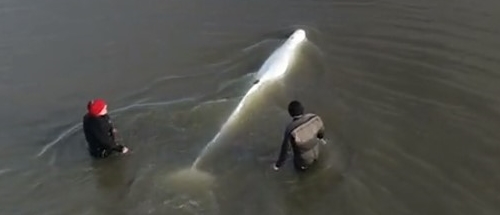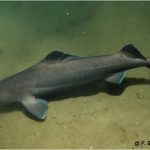← Back
Beluga whales avoid ship noises

Beluga whales are Arctic cetacean very sensitive to noises, including underwater ship noises.
For a long time, scarcity of such ships in the region meant it wasn’t a concern. With ice-free routes opening for longer period with global climate change, the question now arises.
As highly social cetaceans, beluga whales (Delphinapterus leucas) rely heavily on acoustics for communication, foraging, navigation, or predator avoidance (see Argos helps in detecting beluga whale feeding sounds ). As they live in Arctic, for a long time there has been no major concern in link with underwater ship noises due to inaccessibility of ships in the region due to sea ice.
However, vessel traffic has more than tripled over the past three decades in the Arctic waters, and should continue to do so in the future, as more ice-free routes open due to global warming. This is a cause for concern for belugas and other Arctic marine mammals because their natural vocalizations and hearing range overlap with the frequency range of ship noises.
![Left, Map of the locations of the nine tagged belugas during July–December 2018. Colors code individual whale. Right, Map of the ship track-lines derived from automatic identification systems (AIS) data during the same period (Ship track-lines color coded by month) (from [Martin et al., 2022]).](https://www.argos-system.org/wp-content/uploads/2022/12/mms12978-fig-0001-m2-scaled-1.jpg)
Left, Map of the locations of the nine tagged belugas during July–December 2018. Colors code individual whale. Right, Map of the ship track-lines derived from automatic identification systems (AIS) data during the same period (Ship track-lines color coded by month) (from [Martin et al., 2022]).
Nine adult male belugas from the Eastern Beaufort Sea population were Argos tagged. The location data were considered during July–December 2018, in comparison with ship location data from the Automatic Identification System (AIS) system. The tags recorded both Argos and Global Positioning System (GPS) satellite-derived locations. They also included time depth recorders for assessing dive behaviors.
The study reports 177 occasions when ships were within 125 km of tagged belugas during the ice-free period (mainly July-October, November and December in the Bering Sea). Depending on the individual and its migration route, the number of encounters between a tagged beluga and a ship ranged from 2 to 71.
The possible changes in a beluga’s behavior based on their lateral movements (speed and direction) andvertical movements (dives) whenever a ship was within 50 km (23 occurrences) were considered. As some ships may not carry an AIS transponder, the number of number is probably underestimated.
![Beluga whale track (in black) and three ship tracks (in red, orange and purple), with arrows indicating the directions, during a close encounter where beluga avoidance behavior was observed. Bottom, dive profile of the beluga, with the closest point of approach (CPA) between the ship and the whale indicated by the black arrow inside the green box which represents the time period when the whale was within 50 km from the ships. Note the change in lateral movement and diving behavior around the time of the CPA (from [Martin et al., 2022]).](https://www.argos-system.org/wp-content/uploads/2022/12/Whale2_3_ships_08_25-A3-scaled-1.jpg)
Beluga whale track (in black) and three ship tracks (in red, orange and purple), with arrows indicating the directions, during a close encounter where beluga avoidance behavior was observed. Bottom, dive profile of the beluga, with the closest point of approach (CPA) between the ship and the whale indicated by the black arrow inside the green box which represents the time period when the whale was within 50 km from the ships. Note the change in lateral movement and diving behavior around the time of the CPA (from [Martin et al., 2022]).
On these 23 encounters, eight displayed signs of potential ship avoidance responses at distances ranging from 12 km to 43 km from a ship. The most common reaction was to make a sudden change in direction away from the source of the noise, with the whales sometimes circling back to their previous location after the ship had moved on. The belugas also appeared to swim faster at closer distances to ships compared to when ships were further away.
Among those avoidance responses, six showed some degree of shallow diving behavior or subsurface swimming in addition to changes in lateral movements. This can constitute a flee response from the ships, even if at distance far beyond the whales’ visual and echolocation range (more than 10 km). This suggest that belugas are responding to the underwater noise from the ship rather than visual cues. The noise threshold which may trigger such a reaction, and if it is an individual or a collective threshold, is currently unknown.
A hypothesis that belugas might become more tolerant to noise as time goes by has been proposed. Unfortunately, this does not appear to be the case for at least the Eastern Beaufort Sea population because even though traffic has increased in the Arctic, beluga whales still react to ship noises at extremely far distances, and when ship noise is near natural ambient quiet levels. Future studies aim to incorporate biologging tags that can also measure sound underwater so that the exact level of noise from each ship can be measured to better assess the belugas’ reactions.
Reference & links
Martin, M. J., Halliday, W. D., Storrie, L., Citta, J. J., Dawson, J., Hussey, N. E., Juanes, F., Loseto, L. L., MacPhee, S. A., Moore, L., Nicoll, A., O’Corry-Crowe, G., & Insley, S. J. (2022). Exposure and behavioral responses of tagged beluga whales (Delphinapterus leucas) to ships in the Pacific Arctic. Marine Mammal Science, 1–35. https://doi.org/10.1111/mms.12978
Supplementary animations and maps of beluga encounters with ships from Martin et al. 2022:
Main Photo: Release of a satellite-tagged adult male beluga whale from this study (credit Greg Elias)



